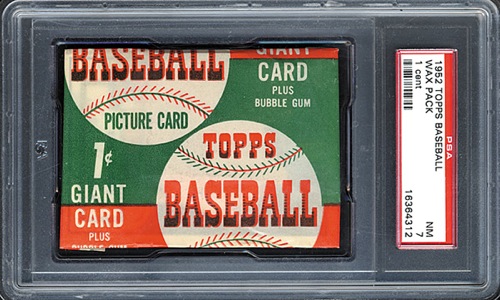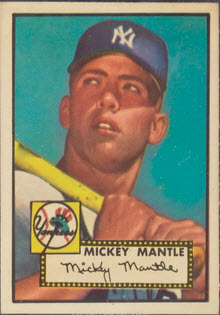The 1952 Topps baseball set may be the most popular baseball card set ever and is undoubtedly the most sought-after set of the post-World War II Era. The pioneering design aspects of Topps inaugural full-set issue, as well as the scarcity of several key cards, make the 1952 Topps set unequaled in collectability.
Bowman had dominated the card market prior to the early 1950s. That’s when Brooklyn-based Topps Chewing Gum Co. decided to attempt a market share “steal” from the Bowman company. At 407 cards, the 1952 Topps set was significantly larger in quantity than the 252-card 1952 Bowman baseball set (Bowman had pared the 1952 numbers down after a 324-set in 1951).
Perhaps more significant, the 1952 Topps cards themselves were also bigger. Topps issued a 2 5/8” x 3 ¾” size. These cards dwarfed the Bowmans which, like the 1951 Bowmans, were 2 1/16” x 3 1/8”. Although the larger size card now seems a no-brainer, the designers at Topps truly gambled at the time on whether larger-sized cards would attract kids who were thought to be mainly purchasing the cards for the gum inside.
The 1952 Topps baseball set also featured design innovations. Topps utilized the larger card size to position a team logo on the front of each card—the first time team logos were used in baseball card design. That the logos were printed in color enhanced the design. The pictures of the players were black and white photos that were vibrantly hand-colored. On the reverse of the cards, Topps printed the statistics of each player for their career as well as the past year. This set the stage for how baseball cards would be designed for decades to come.
The set was issued in six series that were consecutively numbered: 1-80, 81-130, 131-190, 191-250, 251-310 and 311-407. The first series, 1-80, tends to be more difficult to find in high grade, especially the first 10 or 20 cards. The first print run of this series was made with black back cards and includes the famous errors, #48 Joe Page (with Johnny Sain’s writeup on the back) and #49 Sain (with Page’s writeup on the back). The error was corrected in subsequent print runs, which included backs printed in red. Hodges, Rizzuto, Roberts, Snider and Spahn are contained in this series.
series that were consecutively numbered: 1-80, 81-130, 131-190, 191-250, 251-310 and 311-407. The first series, 1-80, tends to be more difficult to find in high grade, especially the first 10 or 20 cards. The first print run of this series was made with black back cards and includes the famous errors, #48 Joe Page (with Johnny Sain’s writeup on the back) and #49 Sain (with Page’s writeup on the back). The error was corrected in subsequent print runs, which included backs printed in red. Hodges, Rizzuto, Roberts, Snider and Spahn are contained in this series.
The 1952 Topps second “sheet” or print run contained 50 double-printed cards (two to a sheet of 100). The third and fourth sheets both co ntained 40 double-printed and 20 single printed cards. Bob Feller (second sheet), Billy Martin’s rookie card (third) and Yogi Berra (fourth) are significant cards in these series. There is a scarce gray-back back variation for cards 131-180; these cards were originally distributed in Canada.
ntained 40 double-printed and 20 single printed cards. Bob Feller (second sheet), Billy Martin’s rookie card (third) and Yogi Berra (fourth) are significant cards in these series. There is a scarce gray-back back variation for cards 131-180; these cards were originally distributed in Canada.
Topps printed fewer cards on the fifth sheet, making them rarer and more collectable. Cards #251-280 and #301-310 were double printed, while #281-300 were single printed. Willie Mays’ first Topps card is included in this relatively scarcer fifth series.
The sixth series of the 1952 Topps baseball set is known as the most rare, regular-issue Topps series of all-time. This series, #311-407, contained 97 single-printings and three double-printings. The three double-printings are the ultra-famous #311 Mickey Mantle, #312 Jackie Robinson and #313 Bobby Thomson. This sixth series is extremely rare, apparently due to Topps not distributing a large amount of the series toward year’s end and then getting stuck with a glut of unsold product which it eventually dumped into the waters near its New York headquarters. Cards that were distributed from this series were also apparently concentrated in the northern states and Canada.
The 1952 Topps baseball set is the most famous Topps set ever, and truly ranks among the greatest baseball card sets of all time. It pioneered a new, larger format for cards that would result in permanent changes within the industry. The design and artwork, as well as the larger backs containing more information, would set the stage for how Topps would make cards for years to come.
Sorry there were no results or an error